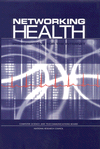
Already the Internet is beginning to influence the health sector by forging new relationships among stakeholders and improving access to health information.
The Internet has great potential to improve Americans' health by enhancing communications and improving access to information for care providers, patients, health plan administrators, public health officials, biomedical researchers, and other health professionals. Ongoing research and development (R&D) efforts, such as the federal government's Next Generation Internet (NGI) initiative and the complementary Internet 2 program of the private sector, could help to realize that potential. Such efforts promote the creation and deployment of new networking technologies to enhance the Internet's capabilities, enabling a growing range of applications in health and other sectors.
But what technical capabilities do health applications demand of the Internet? How do these capabilities differ from those needed by applications in other sectors, such as banking, defense, and entertainment? What types of experiments and demonstrations should be undertaken now to learn quickly about the requirements and benefits of different health applications of the Internet? And how can the health community ensure that its needs are considered within the networking research community and in standards bodies that are defining future capabilities?
Buy the printed version at Amazon!
|
An online e-book about the Internet and health by the Committee on Enhancing the Internet for Health Applications: Technical Requirements and Implementation Strategies, Computer Science and Telecommunications Board, National Research Council
|
Networking Health examines ways in which the Internet may become a routine part of health care delivery and payment, public health, health education, and biomedical research. |
Health Applications of the Internet
Despite its promise, the Internet's future in supporting health and health care is far from assured. A number of technical, organizational, and policy barriers stand in the way of its adoption by health organizations and consumers. Furthermore, although much can be done with the Internet in its present form, some health applications demand greater technical capabilities than the Internet can now provide, especially in the areas of security, reliability, and timely transmission of information. As a result, some health applications cannot be implemented across the Internet and used in operational settings without potentially threatening the privacy and optimal care of patients.
Health applications have helped motivate a number of efforts to improve the nation's information infrastructure.1 Ongoing research and development (R&D) efforts, such as those being pursued under the federal government's Next Generation Internet (NGI) initiative and the private sector's Internet 2 initiative, also hope to foster technologies that could enhance the Internet's ability to meet the needs of the health sector. These efforts will also provide testbeds for improved evaluations of the benefits of different health applications of the Internet and their technical and nontechnical requirements. But these testbeds—and ultimately the Internet itself—will not adequately support health applications unless a better understanding is developed of the technical capabilities that these applications demand.
Consumer health is one of the areas that could be most dramatically reshaped by the Internet. Consumer health refers to a set of activities aimed at giving consumers a more pronounced role in their own health and health care, ranging from the development of tools for self-assessment of health risks and management of chronic diseases, to home-based monitoring of health status and delivery of care.
Click to Read more about Networking Health in the National Research Council's online version of this free to read book.
to page 4 |